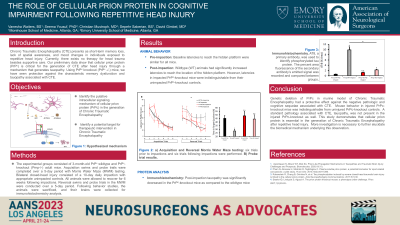The Role of Cellular Prion Protein in Cognitive Impairment Following Repetitive Head Injury
Friday, April 21, 2023


Vanesha A. Waiters, BS (she/her/hers)
Medical Student
Morehouse School of Medicine
Atlanta, Georgia, United States
ePoster Presenter(s)
Introduction: Chronic Traumatic Encephalopathy (CTE) is associated with short-term memory loss, lack of spatial awareness, and mood changes in individuals exposed to repetitive head injury. Currently, no therapy exists for head-trauma besides supportive care. Our preliminary data shows that cellular prion protein (PrPc) is critical for generation of CTE after head injury. Using PrPc knockout (PrPc -/-) mice, we have seen protection against the characteristic memory dysfunction and tauopathy associated with CTE.
Methods: Morris Water Maze (MWM) testing consisted of a multi-day learning trial of wild-type and PrPc -/- mice. For all experimental groups, mice were subjected to a bilateral closed head injury (CHI) with reproducible pneumatic impactions for 10 days. A 6-week recovery period followed to best mimic the delayed nature of CTE initiation. MWM reversal trials were then performed followed by a probe trial. We performed immunohistochemistry and western blot analysis of an array of proteins to note differences in expression between PrPc -/- and control mice regarding CTE and head trauma.
Results: Prior to impaction, time taken to reach the hidden platform is similar between wild-type and PrPc -/- mice. Following impaction, wild-type mice display increased latencies in reaching the hidden platform, whereas latencies remain unchanged in PrPc -/- mice. Impacted PrPc -/- mice exhibited identical memory to unimpacted controls. Furthermore, protein analysis demonstrated critical differences between PrPc -/- and control mice following impaction. The implication of these differences is that PrPc -/- mice are resistant to CTE after head trauma.
Conclusion : Our mouse model of CTE shows profound memory deficit and characteristic histopathological changes. Using the same model, impacted PrPc -/- mice are behaviorally and histologically indistinguishable from uninjured control mice. This observation identifies a novel role for PrPc in the generation of CTE after head injury. PrPc, or its putative intracellular signaling mechanism, provide promising targets for therapeutic intervention.
Methods: Morris Water Maze (MWM) testing consisted of a multi-day learning trial of wild-type and PrPc -/- mice. For all experimental groups, mice were subjected to a bilateral closed head injury (CHI) with reproducible pneumatic impactions for 10 days. A 6-week recovery period followed to best mimic the delayed nature of CTE initiation. MWM reversal trials were then performed followed by a probe trial. We performed immunohistochemistry and western blot analysis of an array of proteins to note differences in expression between PrPc -/- and control mice regarding CTE and head trauma.
Results: Prior to impaction, time taken to reach the hidden platform is similar between wild-type and PrPc -/- mice. Following impaction, wild-type mice display increased latencies in reaching the hidden platform, whereas latencies remain unchanged in PrPc -/- mice. Impacted PrPc -/- mice exhibited identical memory to unimpacted controls. Furthermore, protein analysis demonstrated critical differences between PrPc -/- and control mice following impaction. The implication of these differences is that PrPc -/- mice are resistant to CTE after head trauma.
Conclusion : Our mouse model of CTE shows profound memory deficit and characteristic histopathological changes. Using the same model, impacted PrPc -/- mice are behaviorally and histologically indistinguishable from uninjured control mice. This observation identifies a novel role for PrPc in the generation of CTE after head injury. PrPc, or its putative intracellular signaling mechanism, provide promising targets for therapeutic intervention.
